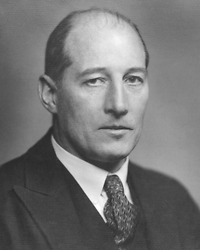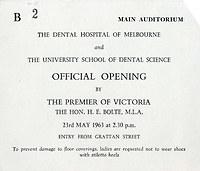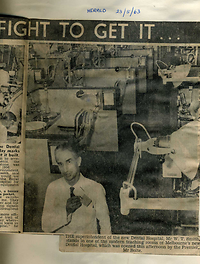


Developing dental education and research in Victoria
Introduction
Participants
Building a dental research culture
The influence of Frank Wilkinson
Developing linkages between the Dental School and Dental Hospital
The art and science of dentistry
The introduction and impact of fluoridation
Resolving a long-standing dispute with dental technicians
Training of dental health therapists
Dentistry's relationship with hospitals, government and industry
Controversy over the Dental School quota
The relationship between the School and the University of Melbourne
Relations between the School and the Australian Dental Association
The role of the School in childhood dental health
Funding research through the CRC and other programs
Personalities
Appendix; Some further thoughts stimulated by the Witness seminar
Endnotes
Index
Search
Help
Contact us

Ann Westmore: Historically, who was responsible for encouraging the scientific approach to dental research and the mentoring of younger dentists?
Henry Atkinson: Frank Wilkinson started things off in Melbourne during the 10 years he was here from 1924. At Manchester he lifted us from the Ďdark agesí, introducing science and appointing a scientist to head the Prosthetic Department.[45] I met him first as a final year student in 1935, after he returned to England. He raised £3 million from industrialists around Manchester for the Manchester [Turner] Dental School before the [Second World] War and it was completed in 1940.

Peter Reade: Wilkinson was medically qualified and was at the beginnings of plastic surgery. He brought his knowledge of trauma during the War to oral surgery. He himself was burned quite seriously while on active duty [during World War II], sustaining facial injuries,[46] and took a particular interest in the repair of head wounds.
He then became Dean of the first postgraduate dental surgery institute in the UK and developed the whole ethos of academic dentistry in the UK.
Garry Pearson: Was he [Professor Wilkinson] responsible for achieving state funding of dentistry in Victoria? My reading of the history of the early dental associations and societies is that they were privately funding the College or School [ie dental education] until some time in the 1920s? Perhaps he was responsible for getting state funding.
Henry Atkinson: The Dental School and the Dental Hospital had been trying to obtain [state] funding since the very beginning. Theyíd been unsuccessful, one reason being that the governing bodies of the two institutions didnít want to lose control.
The Government had said that the School and the Hospital must be separated before it would give money.
That happened in 1925, partly due to Wilkinsonís influence because he was trying to separate the School and the Hospital. He wanted to take the School into the University completely, and separate it from the Hospital.
They (the School, not the Hospital) got a small grant of about £100 in 1925, and after that the grant continued to increase because Wilkinson was putting the School into the University. Then it reversed from 1934.
Ann Westmore: What was the significance of separating the School and the Hospital, in your view?
Henry Atkinson: It was important politically because the same group of people were in control of both School and Hospital. The [Victorian] Government wanted to take control of the Dental Hospital, and the people running the institution didnít want to lose control of it, and they didnít want the University to take control of the School.
All hospitals came under the full control of the governmentís Hospitals and Charities Commission. We at the Dental Hospital wanted the Governmentís money, but didnít want their control.
John Harcourt: I think we should explain that, until the end of 1962, the training of dentists was undertaken by the Australian College of Dentistry which was affiliated with the University of Melbourne, but wasnít part of the University[47] until the opening of the new building in 1963. At that time it was integrated into the University and the Australian College of Dentistry ceased as a teaching body.


But, as members of staff, we were allowed to be superannuated by the University from 1958 onwards.
 |
Witness to the History of Australian Medicine |  |
© The University of Melbourne 2005-16
Published by eScholarship Research Centre, using the Web Academic Resource Publisher
http://witness.esrc.unimelb.edu.au/099.html